Physical Address
304 North Cardinal St.
Dorchester Center, MA 02124
Physical Address
304 North Cardinal St.
Dorchester Center, MA 02124

Just 12 affordable items separate desert hiking success from disaster—discover which gear could literally save your life.
You might think desert hiking requires expensive specialized gear, but most essentials are affordable items you’ll use for years. The key isn’t buying everything at once—it’s understanding which items can literally save your life and which ones simply make your trek more comfortable. From water storage systems that prevent dehydration to navigation tools that’ll get you home safely, these twelve pieces of gear separate successful desert adventurers from those who wish they’d prepared better.
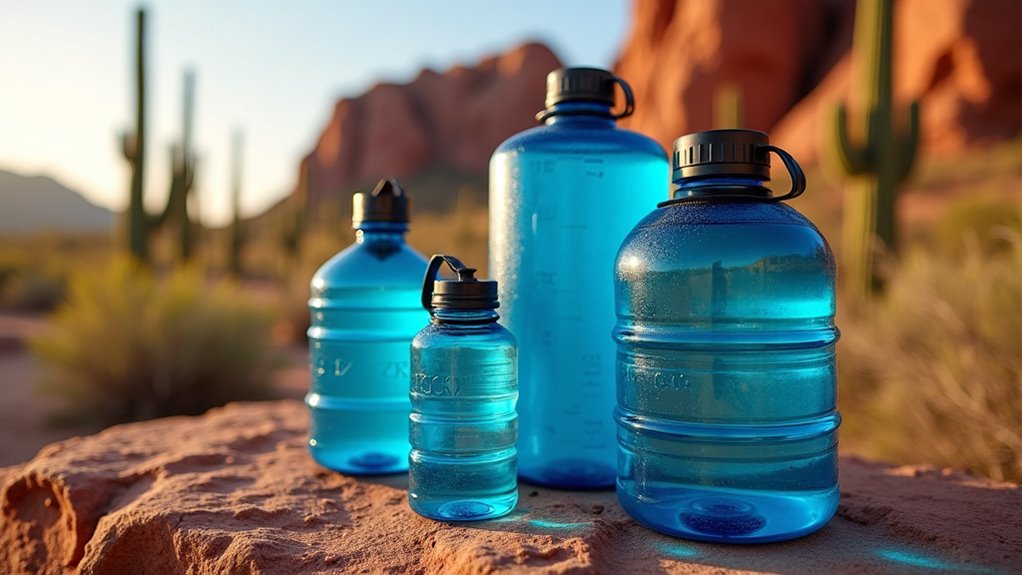
When you’re planning a desert hike, your water storage system becomes your lifeline in an environment where dehydration can turn dangerous within hours. You’ll need at least one gallon per person per day, so invest in a combination of storage options.
A hydration bladder offers hands-free drinking and fits snugly in your backpack, while wide-mouth water bottles make refilling easier and double as backup containers.
Consider collapsible water containers for extra capacity without added weight when empty. Insulated bottles keep water cooler longer, though they’re heavier.
Don’t rely on a single container—redundancy saves lives. Test your system before hitting the trail, ensuring easy access while hiking. While proper hydration is crucial for desert hiking, remember that having the right water storage is just one component of planning a memorable camping adventure in challenging environments.
While water keeps you alive in the desert, proper clothing shields you from the sun’s relentless assault that can cause severe burns and heat exhaustion in minutes. You’ll want lightweight, long-sleeved shirts and pants made from UPF-rated fabrics that block harmful UV rays while allowing airflow.
Light colors reflect heat better than dark ones, keeping you cooler throughout your hike.
Don’t skimp on your hat – choose one with at least a 4-inch brim that protects your face, neck, and ears. A chin strap prevents wind from stealing it away.
Consider adding a neck gaiter or bandana for extra coverage.
These items aren’t just comfort accessories; they’re essential safety gear that prevents dangerous overheating and painful sunburns that could end your adventure early. For ultimate preparedness, consider packing an essential survival kit that contains additional emergency items to support your desert hiking adventure.
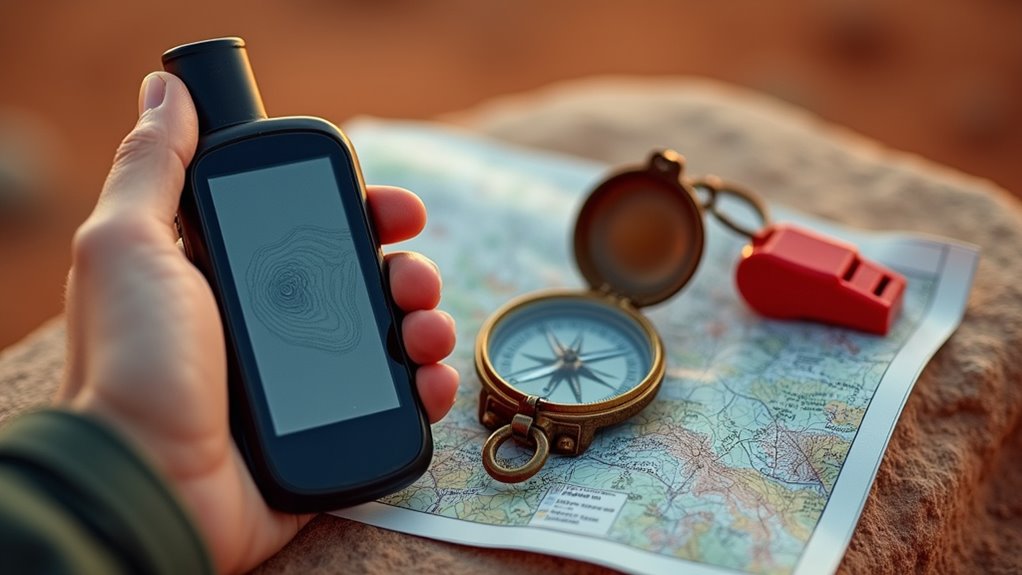
Beyond protecting your body from the desert’s harsh conditions, you need reliable tools to navigate its vast, featureless terrain where getting lost can quickly become life-threatening.
A GPS device is your primary navigation tool, but don’t rely solely on technology. Bring a detailed topographic map and compass as backup – electronics can fail, batteries die, and satellite signals sometimes weaken in canyons or during storms.
Learn basic compass navigation before your trip. Practice triangulation and bearing techniques at home. Download offline maps to your smartphone as an additional backup.
Consider a satellite communicator for emergencies when you’re beyond cell coverage. These devices let you send distress signals and communicate your location to rescue teams.
Always inform someone of your planned route and expected return time before departing.
While GPS devices offer convenience and precision, compass navigation skills remain essential for wilderness safety when technology fails.
Since desert temperatures can shift from scorching heat to surprising cold, you’ll need emergency shelter options that protect against both extremes while providing essential shade during the day.
A lightweight emergency bivvy or space blanket serves double duty—reflecting heat during scorching afternoons and retaining warmth when temperatures plummet at night. You’ll want something compact that won’t weigh down your pack.
Consider these essential shade solutions:
Don’t underestimate how quickly desert conditions can turn dangerous. Having reliable shelter options means you’re prepared whether you’re facing relentless sun exposure or an unexpected overnight situation.
When building your desert survival kit, look for affordable camping gear that meets these shelter requirements without breaking your budget.
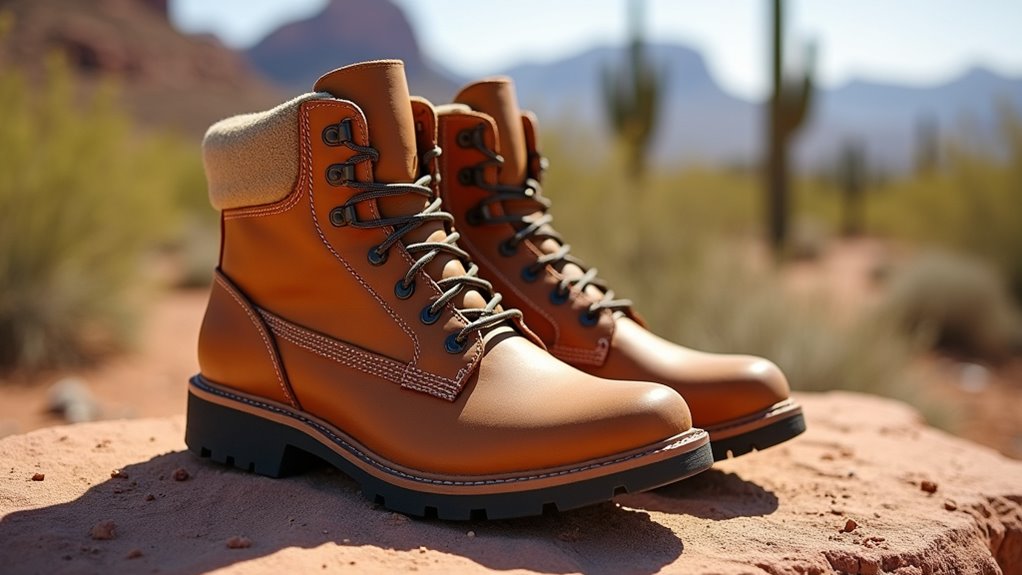
Your feet take the biggest beating in desert terrain, where loose sand, sharp rocks, and uneven surfaces create a perfect storm for ankle injuries. You’ll need sturdy hiking boots with high ankle collars that prevent sand from sneaking in while providing essential lateral support.
Look for boots with aggressive tread patterns that grip both loose sand and slick rock surfaces effectively.
Choose breathable materials like mesh panels or synthetic fabrics over leather, which traps heat and moisture.
Gaiters are your secret weapon – they’ll keep sand, pebbles, and debris out of your boots completely.
Make sure your boots fit properly with hiking socks to prevent blistering in the heat.
Well-fitted, supportive footwear transforms treacherous desert hiking into a manageable adventure. Just like fly fishing enthusiasts who invest in specialized gear for their outdoor pursuits, desert hikers must prioritize quality footwear for both safety and performance.
While your body naturally regulates electrolytes under normal conditions, desert hiking creates an extreme environment where you’ll lose massive amounts of sodium, potassium, and magnesium through sweat. Water alone won’t replace these essential minerals, and deficiency leads to cramping, fatigue, and potentially dangerous heat exhaustion.
You’ll need reliable electrolyte replacement options:
Start supplementing before you feel thirsty or fatigued. Sip electrolyte-enhanced water consistently throughout your hike rather than chugging large amounts. Your body absorbs steady, small doses more effectively than sporadic large quantities.
Whether you’re exploring high-altitude trails like those found in the Andes or tackling desert terrain, proper electrolyte management remains crucial for maintaining peak performance and safety during your adventure.
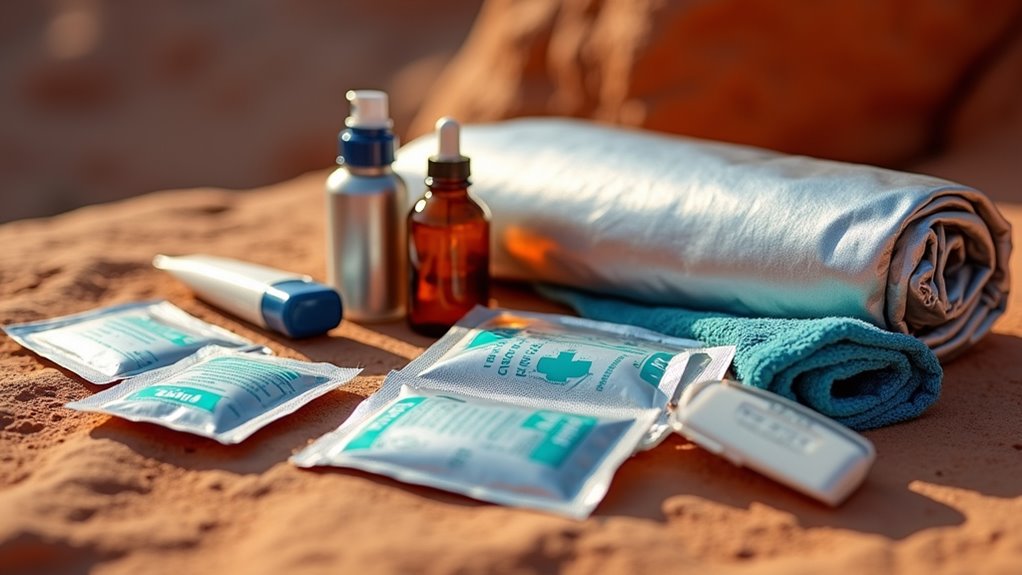
Although standard first aid kits cover basic injuries, desert hiking demands specialized supplies for heat-related emergencies that can escalate quickly in extreme temperatures. You’ll need instant cold compresses to lower body temperature during heat exhaustion episodes. Pack cooling towels that activate with water for immediate relief. Include thermometer strips to monitor body temperature accurately.
Don’t forget oral rehydration salts beyond your regular electrolyte supplements – they’re vital for severe dehydration cases. Add shade cloth or emergency blanket for creating instant shelter. Include extra bandages since desert conditions cause faster fluid loss through wounds.
Consider packing cooling gel patches and antiseptic wipes that won’t dry out in extreme heat. Remember that proper preparation and safety measures are fundamental to preventing emergencies before they occur in challenging outdoor environments. Your expanded first aid kit becomes your safety net when temperatures soar.
Beyond treating heat-related emergencies, you’ll need reliable ways to call for help when desert conditions overwhelm your preparations. Desert terrain can block cell signals and create disorientation, making traditional communication methods unreliable.
Pack these essential signaling devices:
Test your signaling devices before departure and keep them easily accessible. Multiple signaling methods increase your rescue chances since different devices work better under varying conditions. Desert emergencies demand immediate action. Just as you protect your shelter from moisture with proper waterproofing techniques, ensuring your signaling devices remain functional in harsh desert conditions is crucial for emergency preparedness.
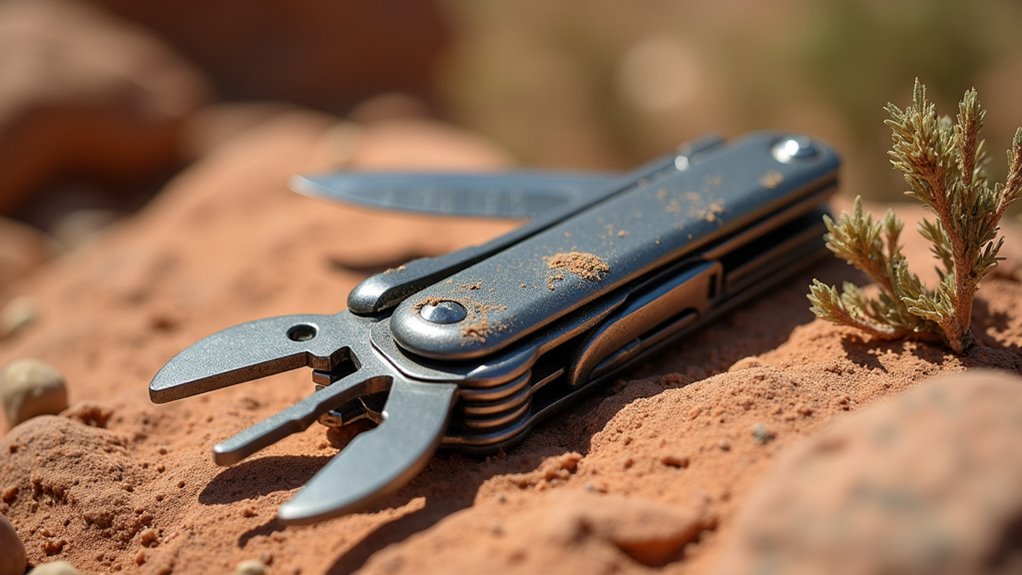
When gear breaks down miles from civilization, a quality multi-tool becomes your mechanical lifeline in the unforgiving desert environment. You’ll need pliers to grip hot metal components, wire cutters for emergency repairs, and multiple screwdrivers for equipment adjustments.
The knife blade handles countless tasks from cutting cord to preparing food, while scissors prove invaluable for medical situations or gear modifications.
Choose a multi-tool with locking mechanisms to prevent accidental closure during use. Stainless steel construction resists corrosion from desert minerals and sweat.
Look for models including an awl for punching holes in leather or fabric, and a file for sharpening other tools.
Keep your multi-tool easily accessible on your belt or in a pocket. Regular maintenance and cleaning ensure reliable performance when you need it most.
Many experienced bushwalking enthusiasts in Australia’s arid regions rely on their multi-tools as an essential piece of safety equipment for remote outdoor adventures.
Since desert sun reflects off sand and rocks while thin air provides minimal UV filtering, you’ll face intense radiation that can cause severe burns within minutes of exposure. You’ll need broad-spectrum SPF 50+ sunscreen that won’t sweat off during strenuous hiking. Apply it generously 30 minutes before heading out, and reapply every two hours.
Your lips are particularly vulnerable since they lack melanin protection. Pack a high-SPF lip balm and use it frequently throughout your hike.
Essential sun protection items include:
Don’t underestimate desert sun’s power—proper protection prevents painful burns that could end your adventure. While desert camping presents unique challenges with sun exposure, you’ll also want to prepare for evening activities when mosquito control becomes essential at your campsite.
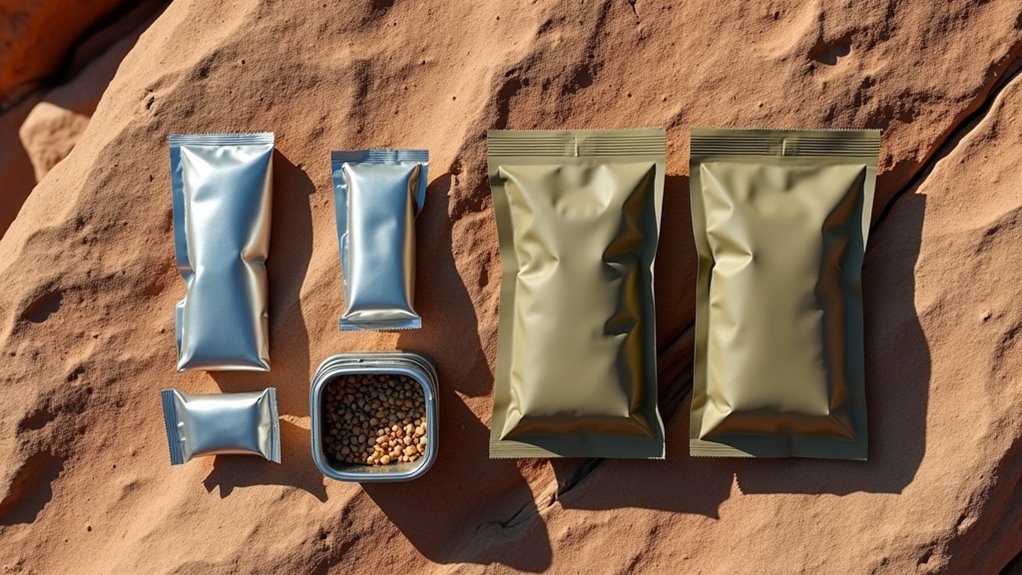
What happens if you’re stranded longer than planned or burn through calories faster than expected? Emergency food rations become your lifeline in the desert. Pack high-calorie, non-perishable options that won’t spoil in extreme heat. Energy bars, nuts, dried fruits, and jerky work perfectly – they’re lightweight and provide sustained energy.
Don’t forget electrolyte replacement packets or tablets. Desert hiking depletes your sodium levels rapidly, and cramping can become dangerous. Choose foods you’ve eaten before; your stomach shouldn’t experiment during emergencies.
Store everything in sealed containers to prevent sand infiltration and protect from curious wildlife. Calculate one extra day’s worth of food beyond your planned trip duration. It’s better to carry a bit more weight than face hunger when you’re already battling desert conditions. Consider packing ingredients for simple camping recipes that can provide hot, comforting meals if you need to set up an extended camp while waiting for rescue or weather to improve.
Desert emergencies don’t wait for daylight, and you’ll need reliable illumination to navigate safely after sunset or before dawn. A quality headlamp keeps your hands free for scrambling over rocks or setting up camp, while backup lighting guarantees you’re never left in darkness.
Your desert lighting arsenal should include:
Choose lights rated for extreme temperatures, as desert nights can drop drastically. Pack extra batteries in a waterproof container, and test all equipment before your hike.
You’ll appreciate dependable lighting when unexpected situations arise. Consider your camping style when selecting lighting gear, as car campers can carry heavier lanterns while backpackers need ultralight options.
Desert hiking’s like building a fortress against nature’s assault—each piece of gear forms your defensive wall. You’ll discover that missing just one essential item can crack your entire strategy. Remember Sarah’s story: she carried everything except electrolyte supplements and ended up dizzy after mile three, forcing an early retreat. Your gear list isn’t just equipment; it’s your lifeline. Pack smart, stay vigilant, and you’ll conquer those sun-baked trails with confidence and safety.